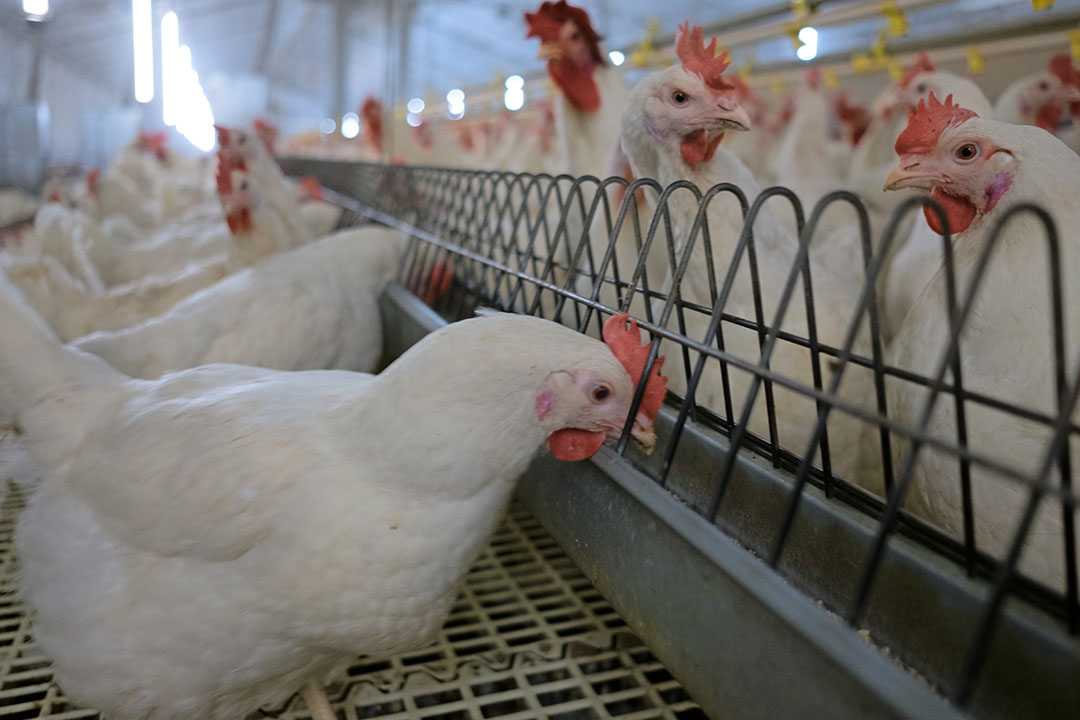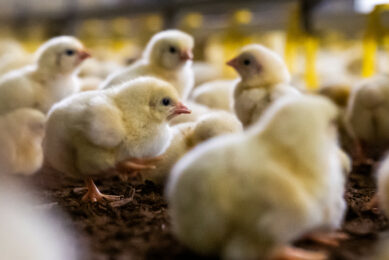Longer feeders lead to better plumage

Research shows that hens that are 50% bald take up almost 20% more feed compared to laying hens with intact plumage.
The condition of a breeder hen’s plumage is important for her internal thermal regulation. Hens with bad plumage are not well insulated which causes them to take in more feed. This leads to suboptimum feed conversion.
Good plumage contributes to better reproduction
Good plumage also contributes to better animal welfare and reproduction. Balder hens have a greater chance of being wounded by other hens during feeding and by males during mating. For breeder hens specifically, bad plumage leads to reduced fertilisation. Mating causes the bald hen pain and the risk of skin damage increases. This may lead to avoidance behaviour because they do not allow mating. Earlier research by Wageningen Livestock Research (WLR) showed that bad plumage is caused, among other things, by a high percentage of male breeders at the start of the laying period, males that have matured too early, a litter surface that is too small (<40%) and too much occupancy of the feeding system. wlr research into the effect of the grill type on preventing chest blisters also took into account the effect of different feeder lengths on plumage.>
 Bird growth boosted through nano minerals in poultry feed
Bird growth boosted through nano minerals in poultry feed
Researchers are claiming that nano minerals in poultry feed can improve broiler growth as well as boosting feed consumption and digestibility.
Practice farm
The farm where the research took place had 4 poultry houses with a total of 21,000 females and 2,000 males (Ross 308). Poultry houses 1 and 2 were similar, as were poultry houses 3 and 4. Poultry houses 1 and 2 measured 14×50 metres, while 3 and 4 measured 15×60 metres. Before the start of the laying period, 4,500 hens (+9% males) were placed in poultry houses 1 and 2 and 6,000 females (+9% males) were placed in 3 and 4. The birds in poultry houses 1 and 2 had 13.6 centimetres of feeder length at their disposal, whereas the birds in poultry houses 3 and 4 had 15.9cms.
Observations: 7 parts of bird scored
Thirty (30) random animals per poultry house were assessed externally at various ages (35, 45, 51 and 58 weeks). At 35 and 45 weeks, they received a complete plumage score, while at 51 and 58 weeks, they were scored for 7 parts per bird (neck, chest, abdomen, back, wings, tail and flanks). Scores of between 0 (plumage fully intact) and 5 (bald) were given. During the final assessment at 58 weeks, the hens in poultry houses 3 and 4 (with more feeder length) had better plumage. After studying the data this effect was also observed at the ages of 35 and 51 weeks (see Table).
In general, the plumage of broiler parent hens depends on 2 factors:
- the percentage of males and
- feeder length (centimetres per hen).
The table shows a minimal difference between the poultry houses in the average percentage of males during the laying period. The hens in poultry houses 3 and 4, however, had 17% more feeder length at their disposal (15.9 cms versus 13.6 cms). Therefore, we expect that the percentage of males hardly influenced the hens’ plumage, while feeder length did show a significant effect on plumage quality. This corresponds with earlier observations in practice poultry houses, where higher feeder (or pan) occupancy resulted in worse hen plumage.
 Preventing excessive feather pecking behaviour
Preventing excessive feather pecking behaviour
Beak trimming has been the go to solution to prevent feather pecking in chickens and turkeys.
Behaviour during feeding
Bad plumage can possibly be explained by pushing, climbing over each other and aggressive behaviour during feeding. Due to the feed control in the breeding phase, hens are used to eating as fast as possible. At the start of the laying period they are still focused on eating quickly, even though they get more feed. In this period there is still a lot of activity around feeding time, with hens climbing and jumping over each other to get to their feed. This pushing behaviour has an adverse effect on the hens’ plumage. When the birds have more feeder length at their disposal, there will be relatively less jostling and competition around feeding time with better plumage as a result. The current results confirm this observation: at the age of 35 weeks, bad plumage was already found (score of 1.7 versus 1.4) in poultry houses 1 and 2 with the shorter feeder length.
Plumage difference increases with feed length
The plumage difference in the poultry houses with the different feeder lengths increased by 0.35 to 0.65 between 35 and 58 weeks of age. This may be caused by the fact that a shorter feeder length keeps resulting in more pushing and competition during feeding time. The research results show that more feeder length can have a positive effect on the hens’ plumage. Wageningen Livestock Research conducted research into the hens’ plumage at a practice farm with broiler parent stock. The results showed that a shorter feeder length can have an adverse effect on the quality of the hen’s plumage.
Research funding
The research into the broiler parent stock was conducted with financial support from the Dutch Ministry of Agriculture, Nature and Food Quality and partners of the Breeders in Balance (BiB) project. This research is part of the Research Agenda of the Dutch Poultry Sector, conducted by Avined. The researchers wish to express their sincere thanks to poultry farmer Barry van Horrik in Someren for his help and commitment during their research.
Author: Rick van Emous and Annemarie Mens, Wageningen Livestock Research











